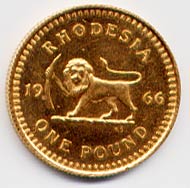Coins of the Rhodesian pound facts for kids
The coins of the Rhodesian pound were the money used in Southern Rhodesia. This country later changed its name to Rhodesia. These coins came after the Rhodesia and Nyasaland pound and the Southern Rhodesian pound. They were an important part of Rhodesia's history and its journey towards independence.
Coins Before Independence (Pre-UDI)
In 1964, new coins were made for the Reserve Bank of Rhodesia. These coins were created at the South African Mint in Pretoria.
Here are the coins that were made:
- sixpence (6d) with a beautiful flame lily flower on one side.
- shilling (1/-) showing the Rhodesian shield.
- florin (2/-) featuring the famous Zimbabwe Bird.
- half crown (2/6) with a Sable Antelope design.
These coins are special for two main reasons. First, Rhodesia was one of the first countries to use Arnold Machin's picture of Queen Elizabeth II on its coins before decimal currency. The other country was The Gambia. Second, these coins had two values printed on them. For example, a sixpence also showed "5c" (5 cents). This was done to help people get used to the new decimal system. It also meant the coins could still be used after the currency changed.
All these coins had Queen Elizabeth II's title written in English. Before this, the coins of Rhodesia and Nyasaland used Latin.
Tommy Sasseen designed the pictures on the back of these coins. He also designed both sides of the coins of the Rhodesian dollar.
Coins During Independence (UDI-Period)
On November 11, 1965, Rhodesia's Prime Minister, Ian Smith, declared that Rhodesia was an independent country. This act was called the Unilateral Declaration of Independence (UDI). Many countries, including the British Commonwealth and the United Nations, did not agree with this. They placed restrictions, called sanctions, on Rhodesia.
In 1966, the Rhodesian government decided to make special gold coins. These coins celebrated the first year of their independence.
There were three different gold coins:
- ten shillings: This coin had a sable antelope on the back.
- one pound: About 5,000 of these were made. It showed the "lion and tusk" crest of Rhodesia.
- five pounds: Only about 3,000 of these were made. This coin featured the coat of arms of Rhodesia.
These gold coins were the same weight, size, and gold amount as the British gold sovereign coins. They were sold individually or as a set of three in special cases. These cases were marked "RESERVE BANK OF RHODESIA". Just like the 1964 coins, these were also made at the South African Mint in Pretoria.
In 1968, Rhodesia also made a threepence coin, sometimes called a tickey. This coin did not have a dual value. It was later replaced by the 2-1/2 Cents coin in 1970.
See also


